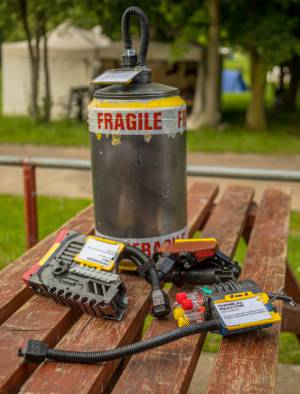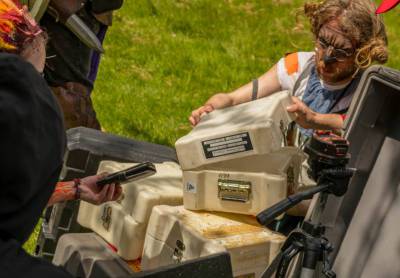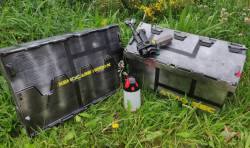Tag Cloud:
User Tools
Sidebar
Table of Contents
Components & Installations
Installations are special equipment that Engineer characters can build at events to accomplish various goals - gathering exotic substances, restoring failing environmental shielding, attracting local wildlife, and many other potential uses. Installations are assembled from Components - various sci-fi parts and equipment that can do interesting things when they are put together to solve specific problems. Components can be sourced on missions, from other characters and potentially bought from NPCs.
The Installation & Component system is intended to provide Engineer characters with a creative improvised route to deal with problems that they encounter at events, combining Components into an ad-hoc technological solution that just might work. Improvised Installations are considered on a case-by-case basis by the Referee who is present, and may not be repeatable in other circumstances. There is a list of “standard installations” at the bottom of this page which should work fairly consistently in relevant circumstances.
Components & Installations Overview
- Components are lammied items that can be found or purchased from various different places or people.
- Components come in two types - Basic and Advanced. 2 Basic Components can be combined into 1 Advanced Component by bringing them to Games Ops and exchanging the lammies (this cannot be done on missions or outside the main event area).
- Component lammies must be attached to a physrep. You can provide your own physreps, or borrow some from the game.
- Components can be used in Installations, and may be required in other tasks.
- Components are consumed when used.
- Installations are built in the field at events by Engineers to do a specific task.
- You can decide what you want your Installation to do, and a Referee will inform you whether it is likely to work or not, or if you need additional items to create it.
- Assembling an Installation is a Card Draw Action performed by Engineers.
- All Installations must be assembled in a Xenocase Installation Box, which can be purchased from the Advanced Armaments Megacorp, and are in limited supply.
- All Installations are composed of at least 1 Advanced Component, and some more Basic Components or other game items.
- Once assembled, Installations cannot be moved or disassembled.
- An Installation will typically have enough power to function for the rest of the event.
- Certain types of Installation may run out of power sooner, or stop working because they become full, etc.
Components
Components are the basic building blocks of Installations - all Installations will require at least 1 Advanced Component (Array), some Basic Components, and possibly some other items like Exotic Substances or other parts. In order to get the effect you want out of an Installation, you need to include the appropriate types of Components. This is often a matter of thinking through how the components you are using might affect the end result - so if you want to build something that does a lot of data processing you might include some Processor Cells or a Computation Array, or if you want to build something that collects things then it should probably include at least 1 Storage Component.
Components are split into 2 categories - Basic and Advanced. Basic Components are simple parts that add to an Installation’s main effect, providing additional functions or abilities. Advanced Components (sometimes called Arrays) are more complex parts that form the core function of the Installation. Advanced Components can be created by combining two specific Basic Components. While the main use for Components at Orion Sphere events is to build Installations, they can also be used to repair or alter pieces of technology, or as part of a Scientist character’s Invention.
Components can be obtained in various ways; you might find some on an abandoned outpost, or gain some as a reward for an Engineering mission, or buy some from a trader. Hiring a Spacer Collective starship to go on a Salvage Mission is also a good way to gather some Components for later use.
There are countless variations of each Component, manufactured by various groups and companies across the Orion Sphere - although small differences exist between these variants, a skilled Engineer will usually have little difficulty in calibrating and connecting then to get the job done. Component lammies should be attached to an appropriate physrep while in the In-character area - you may be able to borrow some physreps from the Game Team for the duration of the event - if so then please hand these physreps in either in your pack at the end of the event, or remove the lammie and hand in the physrep. If you are interested in making your own Component physreps, please do - there are no particular restrictions on what they should look like, other than that they should look vaguely appropriate. The OSLRP Components use this connector designed by Vicki Veck - https://www.thingiverse.com/thing:6746969 - which you may wish to use if you want yours to be able to connect in to general use Components.
Basic Components
There are 10 different types of Basic Components. Basic Components are used for repairing existing technology or to add additional functions or utility to an Installation.
- Chemical Reactors - Specialist precision machines for performing and containing controlled chemical reactions. Chemical reactors often contain some small transparent reaction chambers protruding from the core mechanism.
- Detectors - Parts for detecting and gathering information about the Installation’s surroundings, such as environmental or scientific data. Detectors often feature lenses, dishes or antennae.
- Processor Cells - Computational units for adding additional data processing power to your Installation. Processor cells usually have some electronic chips or flashing lights visible on their exterior.
- Conduits - Specialist cables and shielded conduits for advanced energy or plasma transmission requirements. Installations that deal with Exotic Particles or high powered weaponry often require Conduits. Conduits might take the form of simple cables, or some thickly wound, heavily reinforced tubing tipped with specialised sockets.
- Emitters - Parts for producing and emitting energies or particles. Useful in science, shielding and weapons alike, emitters are often shaped like long structures with lights on them, and may have a series of vanes for heat distribution.
- Power Regulators - Parts for smoothing power supply requirements in delicate or precise technical applications. Power Regulators are often covered with sockets to connect to and may appear as an array of battery cells or capacitors.
- Structural - Parts for providing secure, dampened housing for delicate or hard-wearing devices and instrumentation. Structural components may contain special dampeners, or have special connectors to fit other components to.
- Actuators - Parts for performing internal physical manipulations and mechanical work. Actuators tend to have motors or moving parts protruding from them, or beams and manipulators connected to hydraulic tubes and pistons.
- Storage - Specialist shielded vessels for advanced containment requirements. Storage components tend to be large and have a sizeable empty space inside them, with some attached machinery for creating whatever specific environment is required inside the vessel.
- Databanks - Data storage parts for data gathering and security. May take the form of crystals or rows of solid state data chips, all connected to a central unit.
Advanced Components (Arrays)
There are 5 different types of Advanced Components, each assembled from 2 Basic Components. Advanced Components (also referred to as Arrays) are used for repairing specialist technology or as the Core function of an Installation. All Installations will require a single Array to work, and in rare cases might require more than one.
An Advanced Component can be assembled by taking its two Basic Components and bringing them to Games Ops, where they can be exchanged for an Advanced Component. Once assembled, an Advanced Component cannot be split back into its constituent Basic Components.
- Computation Arrays - An Array for high-power data computation and analysis tasks, such as decoding transmissions, maintaining shield systems and detecting threats. Computation Arrays are built from Processor Cells and Conduits.
- Sensor Arrays - An Array for complex monitoring tasks, important in most scientific or spying equipment. Sensor Arrays are built from Detectors and Power Regulators.
- Collector Arrays - An Array for harvesting materials from the nearby environment, such as exotic substances or minerals. Collector Arrays are built from Structural and Storage Components.
- Manufacturing Arrays - An Array for producing all manner of things, from chemicals to drones to mechanical parts. Manufacturing Arrays are essential components of most life support systems. Manufacturing Arrays are built from Chemical Reactors and Actuators.
- Comms Arrays - An Array for performing high-bandwidth or long-distance communication tasks, including interplanetary messaging and drone control. Comms Arrays are built from Emitters and Databanks.
Installations
Installations are short-term technological assemblages which perform a specific function in their immediate area. Engineers can assemble Installations inside an appropriate container by connecting suitable Components. To create an Installation you need to first come up with a Plan, then gather the required ingredients, and finally assemble the Installation. All Installations require at least one Advanced Component (Array) and are assembled inside an Installation Box, requiring a Card Draw Action by an Engineer (or group of Engineers). At some point, you will need to find a Referee to both explain your Plan to and also to administer the assembly of the Installation itself.
Coming up with a Plan
The first step of creating a new Installation is to come up with a Plan. The Plan should consist of the following;
- An outline of what you want the Installation to do within the game world (the Outcome).
- A list of the Components or other game items you intend to use in the Installation (the Parts).
- An in-character justification for why the Parts should produce the intended Outcome.
This step neatly encapsulates the information that you will need to present to the Referee who will approve your planned Installation. Ideally, coming up with a Plan will ideally consist of a bit of roleplay of your character explaining or working out with other characters what they will need to get the desired outcome - effectively the “technobabble” bit of sci-fi engineering.
Once you have a Plan, you should find a Referee to approve it (and also adjudicate the Assembly part). Ideally this will be a Referee already present on the Mission or job you are doing (who is more likely to have a good handle on how the Installation may influence the situation). Once you have explained your Plan to the Referee, they may approve it, deny it (usually giving an IC reason), or suggest some modification of the Parts or the Outcome that are more likely to work in the current situation. You are encouraged to integrate any additional information or requirements into your roleplay as having come from your own engineering knowledge or that of another character.
Assembling the Installation
- Once you have a plan that has been approved as theoretically viable by a Referee, you may attempt to assemble the Installation.
- Installations must be assembled inside a Xenocase Installation Box, which can be purchased from Advanced Armaments in the MegaCorp area.
- Xenocase Installation Boxes must be used by the end of the current event, after which they are no longer viable - if you have a box at the end of an event, you must hand it in.
- Assembling an Installation is an Engineering Card Draw Action (standard difficulty), requiring one success for every 2 Components used (rounded up).
- If the Card Draw Action to assemble an Installation fails with a Black Card draw, any Components and the Installation Box used in the attempt are destroyed.
- Red Card draws during assembly may damage Components and prevent the Installation working as well as originally intended (which can be mitigated by substituting additional Components of the same type).
- Once assembled, an Installation cannot be moved or disassembled, and any Components used in its construction are consumed.
- Other groups of characters may attempt to interact with an Installation in place, with a Difficult (+1 yellow, +1 red card) Engineering Card Draw Action requiring 3 successes.
- The exact outcome of an Installation (how it works, etc) will vary depending on the approved plan. An Installation will typically have enough power to function for the rest of the event, although some may run out of power sooner, or stop working because they become full, etc.
- Players may have to revisit the Installation to harvest any resources or data it has gathered, and if this is away from the main in-character area you may need to arrange a visit with the Game Team.
- Once an Installation has been placed, the physreps used for it may be removed by a Referee for use elsewhere in the event - if this is the case and you wish to revisit the Installation, please inform the Game Team or Referee Team.
Sample Installations
The following is a list of example Installations and the Components used to assemble them. These Installations may or may not be relevant or useful at any given event.
- Atmo-Scrubber - Super-efficient atmospheric processor, which can filter most noxious chemicals from the environment and rebalances atmospheric gases into a breathable state. Key infrastructure in establishing a presence on toxic worlds, although the scrubber must be contained within an enclosed environment to work. Components - Manufacturing Array (Core), Storage X1, Chemical Reactor X1, Actuators X1
- Biotic Accumulator - A controller and charging hub for a suite of aerial collector drones, programmed to locate rare biological materials in the vicinity and return them for storage. Harvests Exotic Biotics in the local area, which can be collected later or delivered to the installer at the end of the event. The biotics collected and their quantity varies by location, and will be lower if there are multiple Accumulators operating in an area. Accumulators placed on distant worlds or unsafe areas may be destroyed before they can be harvested. Components - Collector Array (Core), Storage X1, Databank X2
- Communications Relay - Versatile communications system specially calibrated for high penetration in toxic atmospheres and high-interference magnetospheres. Capable of wide communication on a planetary or system scale. Can also be set up to deliver warp-packet comms over interstellar distances at 20,000c (typical transit time 1-2 weeks). Components - Comms Array (Core), Conduits X1, Structural X1, Power Regulator X2.
- Corporeal Accumulator - A controller and charging hub for prospector micro-drones, which survey their surroundings for rare materials, and return them to the Accumulator for storage. Harvests Exotic Reagents in the local area, which can be collected later or delivered to the installer at the end of the event. The reagents collected and their quantity varies by location, and will be lower if there are multiple Accumulators operating in an area. Accumulators placed on distant worlds or unsafe areas may be destroyed before they can be harvested. Components - Collector Array (Core), Storage X1, Chemical Reactor X2
- Etheric Accumulator - The complex detectors in this device can identify and attract exotic particles in the local area and store them in specialised magnetic containment bottles for later collection. Harvests Exotic Particles in the local area, which can be collected later or delivered to the installer at the end of the event. The particles collected and their quantity varies by location, and will be lower if there are multiple Accumulators operating in an area. Accumulators placed on distant worlds or unsafe areas may be destroyed before they can be harvested. Components - Collector Array (Core), Processor Cell X1, Detectors X2
- Macro-Shield Booster - This Installation can reinforce the macro-shielding of a space station or planetary base when it is exposed to high levels of radiation or powerful environmental conditions like storms or meteor showers. Components - Computation Array (Core), Emitters X3, Conduits X1.
- Micro-Reactor - Small-scale emergency reactor, able to power larger facilities such as forward bases and small space stations for 2-3 days, after which the reactor will degrade beyond usability. Requires He3 or other fusion fuel. Components - Manufacturing Array (Core), Conduits X2, Processor Cell X2, Power Regulator X2
- Radiation Umbrella - Creates a small, 5m radius area around itself shielded from ionizing radiation. Emitters in the device project various energy fields which repel alpha, beta and gamma radiation, while the data processors direct the emitters to create consistent protection. Components - Computation Array (Core), Emitters X3, Power Regulator X1.
- Seismic Monitor - Detects vibrations in the planet's surface across a wide area using penetrative micro-probes. Uses seismic activity to map structures deep within the planet, useful for asteroid prospecting as well as early warning for major seismic events. Components - Sensor Array (Core), Actuators X1, Processor Cell X2.
- Threat Detector - Monitors the local area for arriving energy and biological signatures, rapidly comparing them to datasets of approved individuals. Raises an auditory alarm when large unrecognised signatures appear in the monitored zone. Components - Sensor Array (Core), Processor Cells X2, Databanks X2.
Components & Installations Design
An important trope of Engineer type characters in sci-fi is to be able to build technological solutions to problems that arise. From Geordi LaForge to Warhammer 40K’s tech-priests, engineers are often able to MacGuyver something together to assist in the story or solve whatever strange sci-fi problem they are having. While Modding and Maintaining equipment reflects the hard sci-fi aspects of engineers, it’s interactions with lammies and place as a downtime activity was limiting players who want to play more active tech-genius style engineers in the field at events. We wanted to add a more flexible and creative system that leaned more into these genre elements, and the Installation system is intended to be that.
Components and Installations were initially trialled at Event 8 to provide the tension of dwindling resources and forcing choices around scarcity on a base that was falling to pieces, while surrounded by a hostile external environment. At this event, Components were theoretically reusable as players could disassemble their Installations as they were no longer needed, or if they became desperate to shore up the bases’ defences and life support. There was a set menu of Installations that could be crafted, and most were tied directly to that event and the story objectives of the characters there. The system worked well at Event 8, so we planned to roll it forward to future events, with new Installations that were more generally useful, and Components being available and used for more things. However, the additional plot effort to integrate Installation recipes into future plotlines and also make them available in a timely manner to players was too demanding, and the system was neglected somewhat.
What surprised us at Event 8 was when characters pitched creating off-book Installations to solve some other problems that we hadn’t envisioned, which we were happy to accommodate at the time, but also the players involved enjoyed being able to come up with an alternative solution to a problem that would work, using this pre-existing system. Hopefully, this ad-hoc Installation system should serve as a means of allowing for creative problem-solving without also putting a significant extra burden on plot writers - as Installations can be used as alternatives to the other possible avenues of interacting with a plotline, but one we can also limit by requiring that Installations use a plan that makes sense given the Components and IC science within the game world.




